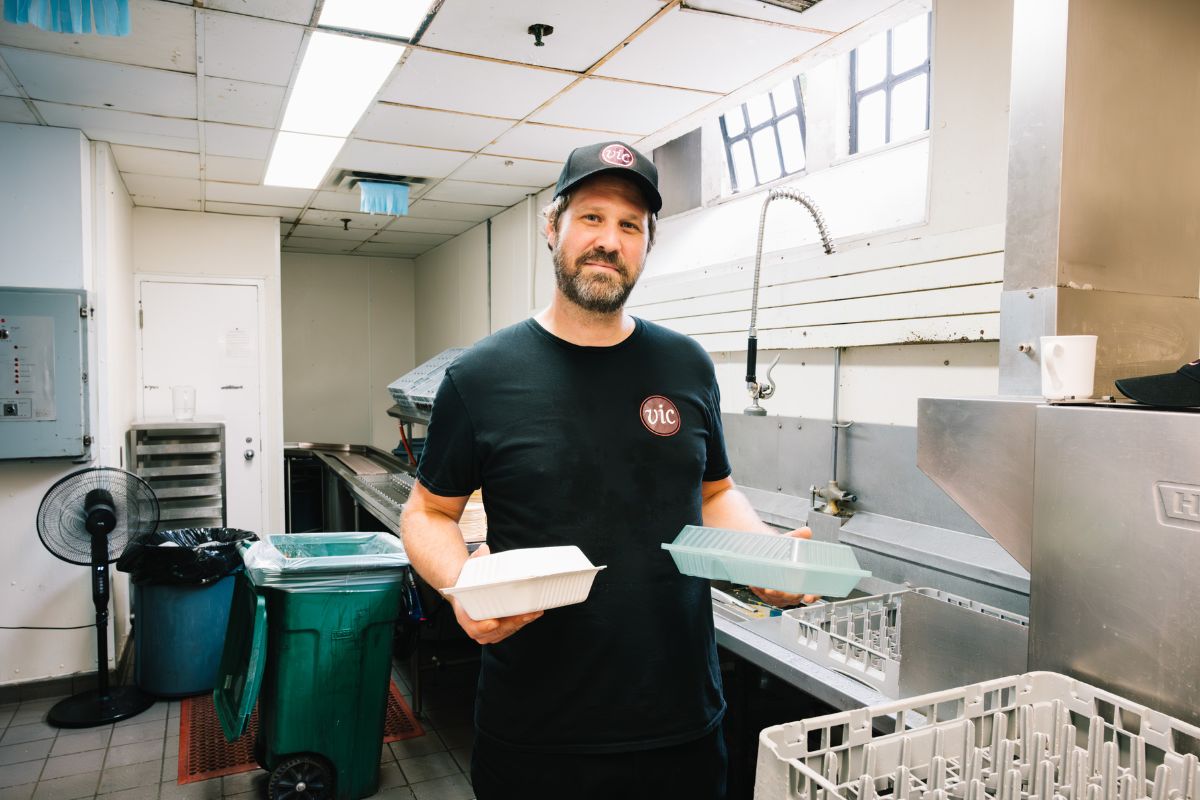Serving Up Sustainability at Burwash Dining Hall

Evan May, lead hand on the Food Services team at Vic U, poses in the kitchen of Burwash Dining Hall. (Photo by Will Dang)
By Dan Blackwell
For more than a century, Burwash Dining Hall has been a Victoria University landmark, known for its iconic architecture and hearty meals. Today, it’s evolving to prioritize sustainability and eco-conscious practices.
"There's been a strong push to bring sustainable practices to Vic," says Ajay Sharma, the university’s associate director of Hospitality Services, who is leading the charge to make both Burwash and Ned’s Cafe greener.
"In recent years, two things have shifted: people are more determined than ever to shrink their carbon footprint, and we're focused on making sure we have the resources to meet that demand."
One of the priorities for Sharma’s team has been to eliminate single-use plastics. Plastic water bottles are no longer sold on Victoria University’s campus, plastic cutlery and plates have been swapped for biodegradable alternatives and Sharma’s team has implemented a reusable container system for takeaway meals.
“U of T has a notoriously large campus, and when students are rushing between classes they don’t often have time to sit and enjoy a meal,” says Sharma, who estimates that around 40 per cent of the food served at Burwash Dining Hall is taken out.
In response to this need for meals on the go, Burwash Dining Hall now provides students with durable, eco-friendly reusable containers for a $10 deposit. After each use, students can exchange their used container for a clean, sanitized one, helping to cut down on single-use disposable packaging.
“The food services team ensures that containers are thoroughly washed, sanitized and dried to maintain high hygiene standards,” says Sharma. “At the end of the year, students return their containers to receive their deposit back. This system offers a practical grab-and-go food solution while minimizing our environmental impact.”
Substantial efforts also go into reducing food waste, says Evan May, Vic U’s lead hand, Food Services. May has worked on the frontlines with Victoria University’s food services team for more than 20 years, and emphasizes that students and staff can work together to help reduce food waste.
"We encourage students not to scrape their plates into garbage cans before placing them on the conveyor belt," he says. “The conveyor belt in our cafeteria leads directly to the dish room, where we have a team of two to four staff members who are trained to sort the waste.”
May says that food waste is placed in compost bins and picked up by a composting company, while recycling and garbage are handled separately. Every year the university receives an independent audit of this process, offering the food services team valuable insights to help further reduce food waste.
May also stresses the importance of students selecting only the food they intend to eat. “We all have eyes that are bigger than our stomach, but we see first hand all the food that goes to waste,” he says. “The biggest difference students can make is taking only what they can eat.”
Sharma emphasizes that his team also focuses on reusing as much food as possible through creative meal planning. Instead of discarding uneaten food from the buffet, the food services team often repurpose items—rice can be transformed into rice pudding or fried rice, and spaghetti sauce can be refreshed as chili. "Repurposing these items reduces our waste and creates tasty meals for the future," Sharma says.
While some sustainability efforts, like eliminating single-use plastics and sorting food waste, can be costly or labour-intensive, Sharma notes that other initiatives are easy choices. For example, his team’s decision to prioritize local produce not only supports the university’s goal of reducing its carbon footprint but also delivers fresher, higher-quality food to customers.
"It’s a win for both the environment and the people we serve," Sharma says. “The food is fresher because it has less distance to travel and we’re supporting local business. The costs are also generally lower and it’s a savings we aim to pass on to our customers.”
Along with teaming up with local farmers and food providers, Sharma's team has also joined forces with local organizations dedicated to food sustainability.
“This year, we’re working with The Better Food Co., Greener by Default and the Canadian Humane Society to enhance our menu with more vegetarian and vegan options,” Sharma says. “Strategic placement of these options within Burwash has been shown to encourage more people to choose them, further reducing our carbon footprint.”
Sharma says his team will adjust Burwash’s menu to celebrate World Vegetarian Day on Oct. 1. However, he emphasizes that their goal is consistent every day: to serve exceptional food while seizing every opportunity for sustainability, no matter how small.
“We’re all on the same side here,” says Sharma. “We need to convey to students the importance of being mindful of what we eat and how we dispose of it. Together, students and staff can make Vic’s food service as sustainable as possible.”
